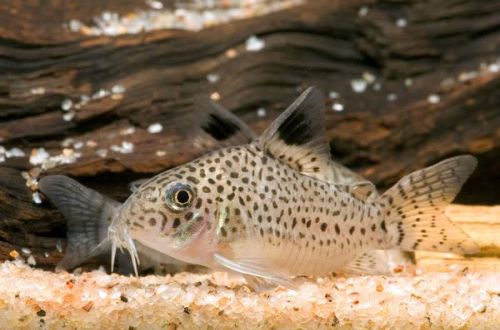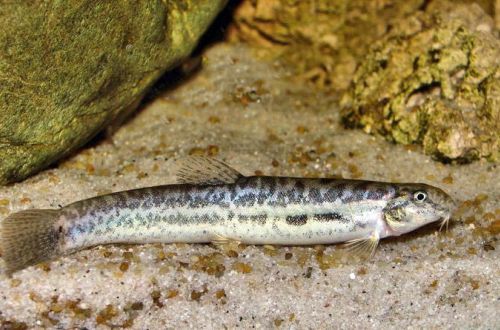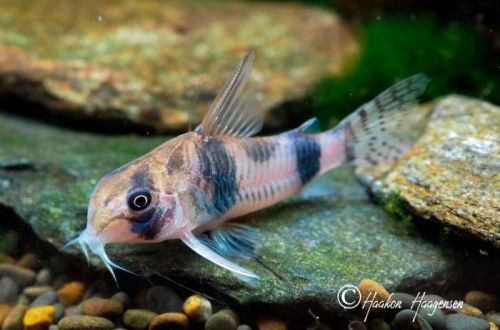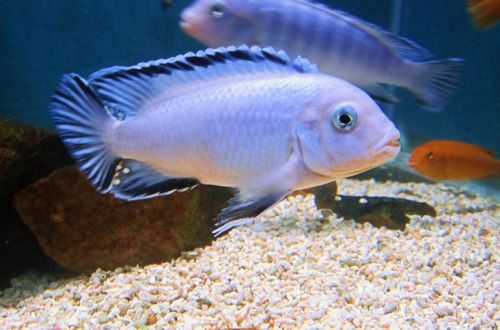
Blue Pindani
Sokolov’s Pseudotropheus or Blue Pindani, scientific name Chindongo socolofi, belongs to the Cichlidae family. Prior to the revision of the classification in 2016, it was referred to as Pseudotropheus socolofi.
Endemic to Lake Malawi in East Africa. It belongs to the group of Mbuna cichlids, which live along the coastline among heaps of rocks. They do not get along well with relatives and other species in a small aquarium. Otherwise, they are simple and unpretentious in keeping and breeding.

Contents
Description
Adults reach a length of about 10-11 cm. The color is delicate blue, the fins have a contrasting dark blue edging. Sexual dimorphism is weakly expressed, males can be distinguished from females only by characteristic yellow dots on the anal fin.
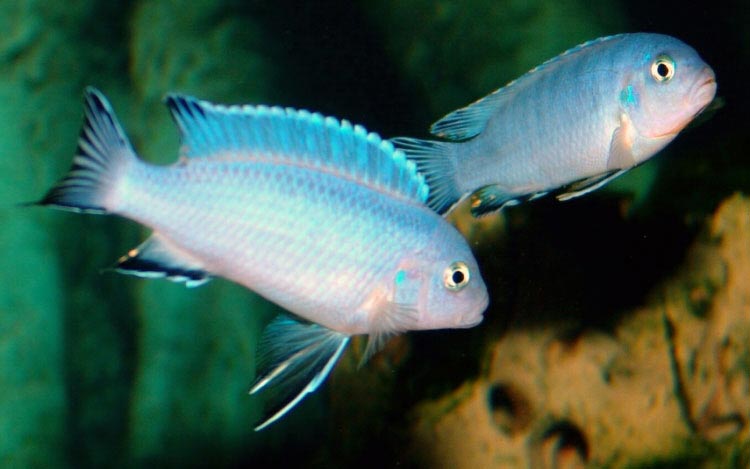
Brief information:
- The volume of the aquarium – from 160 liters.
- Temperature – 24-28°C
- Value pH — 7.6–8.8
- Water hardness – medium to high hardness (10-25 dGH)
- Substrate type – sandy
- Lighting – moderate
- Brackish water – no
- Water movement is weak
- The size of the fish is 10–11 cm.
- Nutrition – any based on plant components
- Temperament – quarrelsome, aggressive during spawning
- Keeping in a harem with one male and several females
Food
In nature, they feed on algae, which are scraped off the surface of stones, and on small invertebrates that come across along with vegetation. In a home aquarium, it is desirable to use specialized food for Malawian cichlids (manufactured by many manufacturers), including all the necessary additives and trace elements.
Maintenance and care, arrangement of the aquarium
To successfully keep a small group of adult fish, you will need a tank of 160 liters or more. The design usually uses a sandy substrate and piles of stones, rock fragments, from which shelters are formed in the form of caves and crevices. The presence of living plants is not necessary, they can be eaten by fish.
Water conditions have high pH and dGH values. The placement of a productive filtration system, along with a weekly replacement of part of the water with fresh water (10–15% of the volume), will help maintain hydrochemical conditions at the proper level. It is advisable to purchase filters with filter materials that increase the hardness of the water in order to avoid strong fluctuations in dGH.
Behavior and Compatibility
Compared to other cichlids, Mbuna is not an aggressive species, but in a small aquarium (up to 200 liters) it is worth keeping only one male and several females, otherwise conflicts over territory cannot be avoided between males.
With regard to fish from other families, not everything is simple either. It is advisable to select among species that are similar or larger in size than the Blue Pindani, living mainly in the upper layers of the water, and also able to live in similar water conditions.
Breeding / breeding
The appearance of offspring of Pseudotropheus Sokolov in favorable conditions is very likely. With the onset of the mating season, the male selects and clears a certain area at the bottom of the aquarium from debris – the future spawning site. Then he begins active courtship, which sometimes looks very aggressive. When the female is ready, she accepts courtship and lays several dozen eggs, which she immediately takes into her mouth. At this moment, the male releases the seed and the eggs are fertilized already in the mouth.
The entire incubation period and the first weeks of life, the fry spend in the mouth of the female. At this time, she does not eat anything and can noticeably lose weight. If before spawning the food supply was not regular or the diet was poor, then the female is likely to release the fry earlier, in the worst case, she will eat them.
During spawning, it is advisable to transplant the neighbors in the aquarium into another tank in order to avoid possible attacks from the male, or vice versa, place the cichlids there, and return them back at the end of the mating season.
For the safety of fry in the future, they are kept in a separate aquarium with identical water conditions.
Fish diseases
The main cause of most diseases is unsuitable living conditions and poor-quality food. If the first symptoms are detected, you should check the water parameters and the presence of high concentrations of hazardous substances (ammonia, nitrites, nitrates, etc.), if necessary, bring the indicators back to normal and only then proceed with treatment. Read more about symptoms and treatments in the Aquarium Fish Diseases section.



